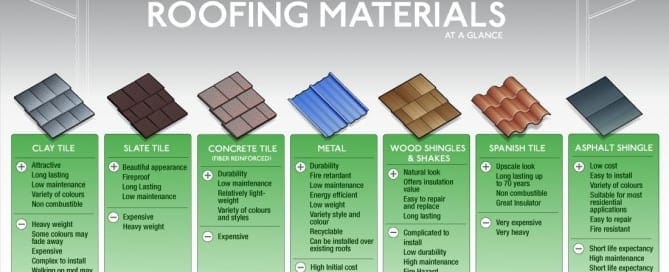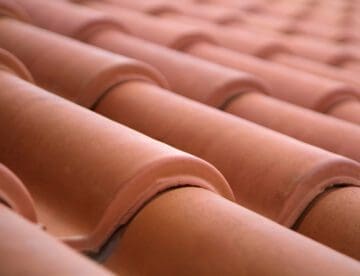There are 75 million single-family homes in the U.S. Of those homes, approximately 7% will replace their roof in 2020. For many homeowners, choosing a new roof can be tricky. Cost is always a factor, and so are aesthetics. You own Victorian-era painted lady in purple? Then a baby blue metal roof is going to look a bit strange. If you’re in the market for a new roof, choosing the right material will also have an impact on your final choice. Some roofing materials are better suited for certain climates than others. Plus, your choice of roofing material may save you money on energy costs throughout the lifespan of the roof. Below, we’ll cover the different roofing materials, and their pros and cons.
Asphalt Shingle Pros and Cons
Asphalt shingles are some of the most common roofing materials you’ll see in the U.S. These shingles are American inventions and were first used as a building material in 1901. Why do people love the iconic and popular asphalt shingle? For one thing, it’s easy to install, so you’ll pay less in labor costs when you put on a new asphalt shingle roof. Another benefit of using asphalt shingles is that the material itself is one of the least expensive roofing materials on the market.
Pros:
- Economical
- Easy to install
Of course, there are several cons to using asphalt shingles. It’s not the most aesthetically pleasing material on the market. Asphalt shingles aren’t the most durable either, compared to say, slate tile or steel roofs. On average, an asphalt shingle roof will last twenty years. If you were to buy your home at age 30 and live there for the rest of your life, you might be looking at replacing the roof at least twice during your lifetime, possibly more. While asphalt shingle will cost less upfront on an install job, you might be reshingling the roof again in twenty years. In contrast, other materials will last a lifetime.
Cons:
- Less attractive than other roofing materials
- Less durable
- Will need to be replaced more frequently than other roofing materials
- Doesn’t offer much in the way of insulation
While an asphalt shingle roof will last an average of twenty years, your mileage may vary. Climate plays a huge role in the lifespan of any roofing material.
Slate Tile Pros and Cons
Slate is not the most popular roofing material in the U.S., at least anymore. In the early 1900s, 1800s and before, slate was a prevalent roofing material. If you live on the East Coast, you may see many older homes still sporting their original slate tile roofs. It’s also difficult to find experienced roofers who can install a slate tile roof correctly. In many parts of the world, slate roofing is a dying art. The pros and cons of slate tile roofing materials are:
Pros:
- Can last for over 100 years
- Very durable material
- Attractive
- Fire-resistant
- Recyclable
Cons:
- Prices are up to six times more expensive than asphalt shingle
- Difficult to find a skilled installer
- Extremely heavy material that often requires reinforced roof framing to install
- Imported slate quality varies
Pros and Cons of Cedar Shingle and Shake
Cedar shingles and cedar shakes have been used as roofing materials for hundreds of years. These materials are often considered as some of the most attractive roofing materials in existence. And like all roofing materials, cedar shake and shingle have their pros and cons, too.
Pros:
- Offer a pleasing, rustic look
- Provides good insulation
- Can last up to 50 years if well-maintained
Cons:
- Highly Flammable
- High maintenance – needs fungicide applied every three to five years
- Prone to mold, mildew, splitting, and rot
Rubber Composite
Rubber composite is also called synthetic slate in some circles. This material is made out of a blend of rubber and plastic that’s bonded on a molecular level.
Pros:
- Durable, yet lightweight
- Looks similar to traditional slate tiles
- Low Maintenance
- Often comes with a 50-year warranty
Cons:
- Uninstalled, can cost up to $400 a square
- It’s a new material with a limited supplier network
Rubber composite is the new kid on the block when it comes to roofing materials. But it’s possible to find a variety of similar synthetic materials on the market that mimic the traditional look of slate and wood, without the costs or associated weight issues. The biggest problem with synthetic roofing material is some of them are prone to water absorption. Also, keep in mind these materials haven’t been on the market for long, so it’s difficult to say exactly how long they’ll last.
Metal Roofing Materials
Metal roofs are becoming increasingly popular across the U.S., and it’s easy to see why. These roofs can last for a long time, come in a variety of colors, and require little maintenance. It’s also possible to find metal roofs that come in thinner, lighter sheets that are suitable for a range of buildings.
Pros:
- Last up to 50 years
- Resistant to fading for up to 25 years
- Low maintenance
- Solar resistant
- Durable
- Recyclable
- Can withstand a range of climates and weather conditions
Cons:
- Can be expensive, with costs ranging from $100 a square, up to $800 a square
- Can be noisy
- Thinner sheets are easily dented
You can purchase metal roofing materials in panels or shingles. Metal roofs come in copper, stainless steel, aluminum, and zinc. Aluminum metal roofs are resistant to rust but can be prone to denting.
The Pros and Cons of Roofing Materials: A Takeaway Message
This list isn’t exhaustive, and having a lot of choices for roofing materials has its pros and cons, as well. Choice overload can be a problem for indecisive homeowners. If it’s time for you to have a new roof installed, don’t be afraid to ask for samples of roofing materials from different contractors when you’re shopping for quotes. Looking at different samples will give you a good idea of what material will be right for your home.
After you’ve chosen a roofing material for your home, it’s critical to find a reputable contractor to install the new roof. We can help. Contact us today for a free, no-obligation quote.




